Quick Look
Grade Level: 4 (3-5)
Time Required: 45 minutes
Lesson Dependency: None
Subject Areas: Earth and Space
NGSS Performance Expectations:

| 5-ESS2-1 |

Summary
Students are introduced to the fabulous planet on which they live. Even though we spend our entire lives on Earth, we still do not always understand how it fits into the rest of the solar system. Students learn about the Earth's position in the solar system and what makes it unique. They learn how engineers study human interactions with the Earth and design technologies and systems to monitor, use and care for our planet's resources wisely to preserve life on Earth.Engineering Connection
Engineers must know as much as they can about our planet so that they can create systems, structures, energy technologies, products and inventions to best meet the needs for a sustainable future on the only planet humans can call home. Engineers measure and track changes to our planet's environmental conditions over time, analyzing the effects of humans. When problems or harmful trends arise (such as changes to our environment caused by human-generated pollutants), engineers come up with creative tools and solutions to help the Earth and protect the people and animals that depend upon its resources and habitable environment.
Learning Objectives
After this lesson, students should be able to:
- Describe several characteristics of the Earth, such as third planet from the Sun, supports life, variety of natural resources (air, water, soil, minerals, oil, food, plants, animals, etc.).
- Give examples of how the Earth changes over time.
- Explain that engineers develop technologies to help protect the Earth and its inhabitants.
Educational Standards
Each TeachEngineering lesson or activity is correlated to one or more K-12 science,
technology, engineering or math (STEM) educational standards.
All 100,000+ K-12 STEM standards covered in TeachEngineering are collected, maintained and packaged by the Achievement Standards Network (ASN),
a project of D2L (www.achievementstandards.org).
In the ASN, standards are hierarchically structured: first by source; e.g., by state; within source by type; e.g., science or mathematics;
within type by subtype, then by grade, etc.
Each TeachEngineering lesson or activity is correlated to one or more K-12 science, technology, engineering or math (STEM) educational standards.
All 100,000+ K-12 STEM standards covered in TeachEngineering are collected, maintained and packaged by the Achievement Standards Network (ASN), a project of D2L (www.achievementstandards.org).
In the ASN, standards are hierarchically structured: first by source; e.g., by state; within source by type; e.g., science or mathematics; within type by subtype, then by grade, etc.
NGSS: Next Generation Science Standards - Science
| NGSS Performance Expectation | ||
|---|---|---|
|
5-ESS2-1. Develop a model using an example to describe ways the geosphere, biosphere, hydrosphere, and/or atmosphere interact. (Grade 5) Do you agree with this alignment? |
||
| Click to view other curriculum aligned to this Performance Expectation | ||
| This lesson focuses on the following Three Dimensional Learning aspects of NGSS: | ||
| Science & Engineering Practices | Disciplinary Core Ideas | Crosscutting Concepts |
| Develop a model using an example to describe a scientific principle. Alignment agreement: | Earth's major systems are the geosphere (solid and molten rock, soil, and sediments), the hydrosphere (water and ice), the atmosphere (air), and the biosphere (living things, including humans). These systems interact in multiple ways to affect Earth's surface materials and processes. The ocean supports a variety of ecosystems and organisms, shapes landforms, and influences climate. Winds and clouds in the atmosphere interact with the landforms to determine patterns of weather. Alignment agreement: | A system can be described in terms of its components and their interactions. Alignment agreement: |
International Technology and Engineering Educators Association - Technology
-
The use of technology affects the environment in good and bad ways.
(Grades
3 -
5)
More Details
Do you agree with this alignment?
-
Explain how various relationships can exist between technology and engineering and other content areas.
(Grades
3 -
5)
More Details
Do you agree with this alignment?
State Standards
Colorado - Science
-
Gather, analyze, and interpret data about components of the solar system
(Grade
4)
More Details
Do you agree with this alignment?
-
Use evidence to develop a scientific explanation of what plants and animals need to survive
(Grade
4)
More Details
Do you agree with this alignment?
Worksheets and Attachments
Visit [www.teachengineering.org/lessons/view/cub_solar_lesson04] to print or download.Introduction/Motivation
Earth — it is our home in space. "It looks like a big blue marble from out there." That's the slogan of the award-winning PBS program from the 1970-80s called "Big Blue Marble." No one knows for sure who was first to use this famous phrase to describe planet Earth. Some say it was the crew of Apollo-8, who reached and orbited the Moon in 1968.
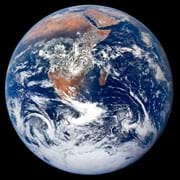
Ever since then, photographs of the Earth from space have been called "blue marble" images (see Figure 1). Seeing our plant from this distance gives us a sense of how beautiful, fragile and unique our home is and how important it is to understand and preserve it. Engineers play a key role in developing technologies and designing systems that help us to use the Earth's resources wisely in order to keep them around for the future.
Do you think that the Earth changes over time? Of course it does! Water moves, ground erodes, the crust (land) moves, and plants and animals come and go. These are just a few examples of how the Earth changes. Some things on Earth change within predictable cycles. For example, the Earth cycles (rotates) on its axis once each day and cycles (revolves) around the Sun once each year. The 23.5o tilt of Earth's axis results in the cycle of the seasons.
The water cycle is another of Earth's amazing cycling mechanisms, as water evaporates into the atmosphere and falls to the surface again as precipitation. Plate tectonics are another example of cycling. The shifting of the plates that make up the Earth's crust start earthquakes and move mountains, causing some land to sink and other land to rise. The volcanic activity brings molten rock from within the Earth to the surface to create new land masses. Sometimes we call earthquakes and volcanic eruptions natural "disasters" when they hurt people, but they are just the Earth's natural processes, changing over time.
Compared with other planets such as Venus, Jupiter and Uranus, our Earth is a steady place, changing very slowly. But, since it is always changing, our planet provides plenty of mysteries for scientists and engineers to study. Engineers examine how over the centuries, people who lived on Earth have had an impact on their environment. Engineers design ways to help keep the Earth safe enough for us to live here. For example, engineers design technologies to reduce human-made pollution in the air, water and soil, so as to keep it safe for animals and plants, including people.
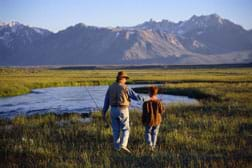
(Optional: Show students an image of all the planets in our solar system, so they understand their relative position from the Sun; see the attached Solar System Map Visual Aid.)
The Earth provides us with life-sustaining water, air, shelter and food. Do you know of another planet that would do that for humans? Earth is the third planet from the Sun, and it is the only planet in the solar system known to support life. Earth has many resources to help living things survive, such as the atmosphere, soil, minerals, oil, coal, water and energy from the Sun. Can you think of all the ways we depend upon these resources? We breathe the air. We burn coal to create electricity to heat our homes and schools. We eat plants and animals for food. We use rocks and soil to make roads and shelters. We use land and water for growing food and fabric crops. We rely upon water for drinking and washing. Refer to the associated activity Designing Ways to Get and Clean Water where students can learn about the design and investigation process engineers apply to ensure clean water for our usage! Engineers design tools to use the Earth's resources, such as wind, water and sunshine, to make energy to power our homes and schools. Engineers design the technologies associated with everything we just mentioned. Following the lesson, conduct the associated activity The Great Gravity Escape to draw connections between gravity and earth's orbital properties.
Lesson Background and Concepts for Teachers
Scientists often describe the Earth by the various "spheres" that together create a complex interactive system — the "biosphere" or "ecosphere" — that makes life possible on Earth. Our planet's atmosphere is composed of gases that are necessary for us to breathe, shield us from radiation, create weather and, through the water cycle, enable plants to grow. The Earth's hydrosphere is made of water that is essential to life and takes up about 70% of the Earth's surface. The lithosphere includes the rocks, sands and soils that make up the rest of the surface. Plate tectonics is the study of how the Earth's crust is continuously shifting and renewing itself through the action of earthquakes and volcanoes. The magnetosphere encompasses the magnetic field that shields Earth from harmful cosmic rays and solar "winds."
Earth's Seasons
Our planet rotates on its imaginary axis at a surface speed of about one-half kilometer per second at the equator and revolves around the Sun at about 30 km per second. That's fast, but because motion is relative, we do not feel it. To us, the Earth seems to be standing still. Instead, we experience the motion of the Earth in the movement of the Sun across the sky and in the much slower cycle of the seasons. The four seasons are a result of Earth's axis of rotation being tilted at 23.5o.
Earth's Atmosphere
A thin layer of atmosphere — composed of 78% nitrogen, 21% oxygen, and 1% other constituents — separates us from the vacuum of space, shields us from harmful radiation coming from the Sun, and protects us from meteors, most of which burn up before they can strike the surface of the Earth. The part of the atmosphere that we call home — the troposphere — is an even thinner shell, only 12 km (7.5 mi) thick. It is in the troposphere where all our weather occurs.
Earth's Hydrosphere
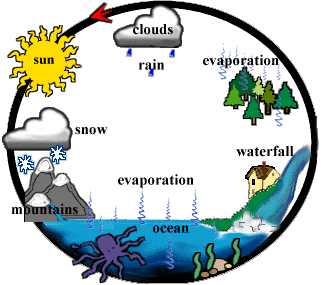
Water is liquid only within a narrow temperature span (0 to 100 oC). Contrasted with the full range of temperatures found in the solar system, this temperature span is especially narrow, neither too hot nor too cool. Fortunately for us, 70% of Earth's surface is covered by water: lakes, ponds, rivers, streams, creeks, oceans, seas, estuaries and tide pools. The rest of Earth is land: mountains and valleys, volcanoes, plains, deserts, forests and the boundary zones known as wetlands. Water vapor in the atmosphere is responsible for much of the Earth's weather and produces the water cycle that transports water as rain to sustain plant life on land. The water cycle (see Figure 2) consists of water evaporating from bodies of water and plants. It then condenses to form clouds, which travel around the planet. The clouds release the water as precipitation and then it flows back into bodies of water.
Earth's Lithosphere
The Earth is not a solid mass; it has several distinct layers, of which some are rigid and others are "plastic" or movable. The Earth's brittle crust floats on a liquid layer called the asthenosphere (see Figure 3). This liquid is molten rock (rock that has melted because of intense heat). We see this molten rock when it escapes as lava from volcanoes. The land masses of Earth are plates, rather like slices of bread floating on a very thick soup. These plates run into each other, under each other, and push against each other, causing earthquakes.
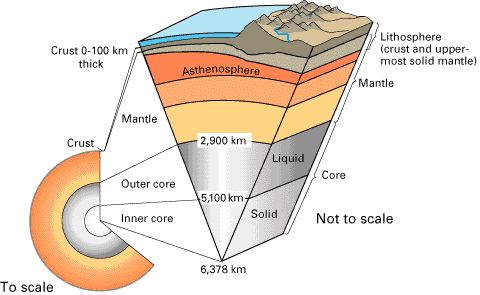
Earth's crust is divided into 10 major plates that are constantly on the move. The North American plate, for example, is moving west over the Pacific Ocean basin. The rate of speed is imperceptibly slow, roughly the rate our fingernails grow. But in time, give or take a few million years, we could be shaking hands with China. When the plates grind past one another causing earthquakes, we become suddenly aware of the movement of the plates. The plates also ride up over one another, or collide to make mountains, or split and separate. These movements are known as plate tectonics, a study that has fully developed only within the last 40 years.
Earth's Magnetosphere
Our planet's molten iron-nickel core and rapid spinning on its axis cause it to behave like the small bar magnets we have on Earth. The Earth has a North and a South Pole. However, satellite mapping has revealed that due to the effects of the solar wind (streams of charged particles emitted from the Sun) the magnetosphere is shaped more like a teardrop and has definite boundaries (see Figure 4).
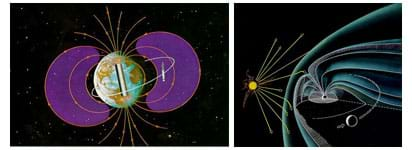
Planet Quick Facts
Amazing facts about Earth may be found in Table 1.
|
Fact |
Earth |
| Distance from the Sun | 149,597,890 km |
| Mass | 6.0 x 10^24 kg |
| Radius | 6,378.14 km |
| Orbit | 1 Earth year |
| Min/Max Surface Temp | -88/58 degrees C |
| Number of Moons | 1 |
| Ring System | No |
| Atmosphere | Nitrogen, oxygen |
Table 1
Engineering and the Earth
The planet Earth provides us with life-sustaining water, air, shelter and food. Engineers work with its limited resources, including the atmosphere, soil, minerals, water and energy sources, to help living things survive. They figure out ways to keep our air, water and soils clean. They design ways to make shelters that use and recycle natural resources, and protect us from natural hazards like earthquakes, floods and storms. They work to devise cleaner ways of obtaining electricity than from fossil fuels – such as wind, water and solar energy. They also work on ways to support food and crops that do not ruin the water, soil and ecosystems. They design communication tools and products.
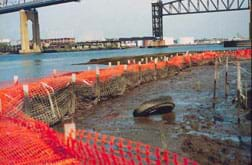
Environmental engineers create many technologies and approaches to reduce and eliminate pollution from spoiling our natural resources. Strategies to reduce pollution and erosion for community, agricultural, forestry and marina areas include: buffer strips, retention ponds, constructed wetlands, porous paving materials, sediment fences, retaining water fences, conservation tillage, beneficial insects, log road design and placement, replanting trees, shutoff valves at dock fuel pumps and marina sewage pump-out stations. See more details at NOAA's Nonpoint Source Pollution website: https://oceanservice.noaa.gov/education/tutorial_pollution/welcome.html.
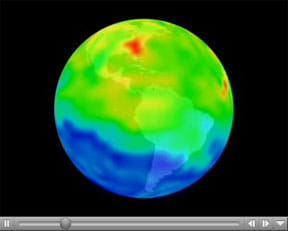
Engineers also design tools to help us see what is happening on our planet from space. NASA's Terra spacecraft measures carbon monoxide (CO) levels 2-3 miles above the Earth's surface. Carbon monoxide is an air pollutant that produces ozone, a greenhouse gas. The data is combined with wind measurements to create image sequences that show the world's air pollution moving through the atmosphere, crossing continents and oceans. See Figure 6 for an example still shot taken from an animation of global air pollution from space. Red indicates the highest level of CO; blue is the lowest level. This tool helps to identify the major sources of air pollution and track their movements. See the full animation at the NASA Goddard Space Flight Center website at https://svs.gsfc.nasa.gov/31076.
Associated Activities
- Designing Ways to Get and Clean Water - Students design ways to either clean a water source or find a new water source, depending on hypothetical scenarios. They learn the steps of the engineering design process as they explore ways to provide water to a community facing a water crisis.
- The Great Gravity Escape - Students use water balloons and string to understand how gravity and the speed of an orbiting body balance to form an orbit. They also see that when the velocity exceeds the escape velocity, the object escapes the gravity of the Sun or planet that it orbits.
Lesson Closure
Earth is the third planet from the Sun, and the only planet in the solar system known to support life. What are some of Earth's natural resources? (Possible answers: Air, soil, minerals, oil, sunshine and water.) How does the Earth change over time? (Examples: The Earth cycles [rotates] on its axis once each day, cycles [revolves] around the Sun once each year, the tilt of Earth's axis causes the seasons, the water cycle moves water through the Earth and atmosphere, plate tectonics continually move the Earth's land.) Engineers study how humans affect the Earth and develop technologies to help us sustain the natural resources on Earth. What might an engineer do with information about how humans are polluting the Earth environment? (Answer: Engineers might design technologies to reduce the pollution.)
Vocabulary/Definitions
atmosphere: The gas bound to a planet by its gravity. Earth's atmosphere is composed of 78% nitrogen, 21% oxygen, and 1% other constituents.
axis: An imaginary line running through the Earth, between the North and South Poles.
engineer: A person who applies his/her understanding of science and math to creating things for the benefit of humanity and our world.
plate tectonics: The relative motion between the large geological plates that make up the Earth's surface.
revolve: To orbit around a central point, as the Earth revolves around the Sun.
rotate: To spin on an axis.
water cycle: The cycle of evaporation, condensation and precipitation that naturally purifies and recycles water on Earth.
Assessment
Pre-Lesson Assessment
Voting: Ask a true/false question and have students vote by holding thumbs up for true and thumbs down for false. Tally the votes and write the totals on the board. Give the right answers.
- True or False: The Earth is a solid. (Answer: False. The Earth is actually mostly molten (liquid) rock. It is liquid because it is very hot in the center of the Earth.)
- True or False: The Earth is the only planet where humans live. (Answer: True. As far as we know, the Earth is the only planet in the solar system known to support life.)
Post-Introduction Assessment
Discussion Questions: Solicit, integrate and summarize student responses.
- How does the Earth change over time? (Possible examples: Erosion, water cycle, plate tectonics, weather patterns, etc.)
- Why do engineers want to learn about the Earth? (Have students turn to a partner and discuss. Possible answers: By understanding the Earth and how it works, engineers can better protect it [such as from human-made pollution], minimize the harmful effects on humans from natural disasters that are really just a natural part of the Earth's changes, and better understand other planets and the rest of the solar system.)
Lesson Summary Assessment
Concept Presentations: Divide the class into small teams. Assign each group a particular concept (such as: life on Earth, essential Earth resources; Earth cycles, how the Earth changes over time, human impacts on the Earth, engineering designs that help the Earth, solar system location of Earth in relation to other planets). Have each group come up with a way to teach the other groups the important understanding they should take away from their assigned concept. Teams are free to teach in any method. They might present a poem, acronym, skit, song or game. Give them time to brainstorm and practice their presentations before "showtime."
Engineering and the Earth: Have student teams pick one of the following facts about our planet (or come up with your own) and briefly explain how engineers might design something using this fact. Encourage students to be creative and look for answers that show engineers developing useful technologies.
- Earth is the third planet from the Sun. (Examples: Ways to observe Earth from space, ways to observe the Sun.)
- Earth is the only planet with life on it. (Examples: Anything that supports life.)
- Inhabitants (humans) on Earth pollute the water. (Examples: Things that help clean up water.)
- Inhabitants (humans) built communities at locations in which earthquakes occur. (Examples: Things that measure earthquakes or strong shelters to withstand earthquakes.)
- The Earth has seasons. (Examples: Things to predict weather or to protect people from changing seasons.)
- Land (soil) is one of the Earth's natural resources. (Examples: Anything that uses soil.)
Lesson Extension Activities
Assign students to discover how the big blue marble images are generated. Start with the NASA website: https://www.nasa.gov/ and (https://earthobservatory.nasa.gov/features/BlueMarble).
Look into the impact that the original blue marble images had on the environmental movement. Invite an environmental engineer to talk to the class. Investigate various environmental technologies designed by engineers, such as: solar/energy cells, hybrid vehicles, energy-efficient building designs and technologies, low-head hydropower, recycling systems.
Additional Multimedia Support
Show students a flash animated interactive water cycle activity that lets you control the water cycle as you learn. See the U.S. Environmental Protection Agency's website for teachers (K-3): https://www3.epa.gov/safewater/kids/waterfactsoflife.html.
Learn more about the impact of humans on the condition of the Earth at: https://www.nationalgeographic.org/topics/resource-library-human-impacts-environment/?q=&page=1&per_page=25.
Subscribe
Get the inside scoop on all things TeachEngineering such as new site features, curriculum updates, video releases, and more by signing up for our newsletter!More Curriculum Like This

Students explore the outermost planets of our solar system: Saturn, Uranus and Neptune. They also learn about characteristics of Pluto and its interactions with Neptune. Students learn a little about the history of space travel as well as the different technologies that engineers develop to make spa...

Students are introduced to the International Space Station (ISS) with information about its structure, operation and key experiments.

In this lesson, students are introduced to the five types of renewable energy resources by engaging in various activities to help them understand the transformation of energy (solar, water and wind) into electricity. Students explore the different roles engineers who work in renewable energy fields ...

Students learn the metric units engineers use to measure mass, distance (or length) and volume. They make estimations using these units and compare their guesses with actual values. To introduce the concepts, the teacher needs access to a meter stick, a one-liter bottle, a glass container that measu...
References
Dejoie, Joyce and Trulove, Elizabeth. Earth: The Water Planet, StarChild – A Learning Center for Young Atronomers, Goddard Space Flight Center, NASA. Accessed February 28, 2007. http://starchild.gsfc.nasa.gov/docs/StarChild/solar_system_level2/earth.html
Fox, Win and Geldon, Marjorie. The Big Blue Marble Web Quest. Last updated February 13, 2002. Montgomery County Public Schools, Rockville, MD. http://www.mcps.k12.md.us/schools/chevychasees/bigblue/bbwebquest.htm Accessed February 28, 2007.
Jenner, Lynn (editor). NASA's Terra Satellite Tracks Global Pollution. Web publication May 18, 2004.Last Updated February 23, 2008. News & Events, Top Story Archives, Goddard Space Flight Center, NASA. Accessed October 24, 2011. http://www.nasa.gov/centers/goddard/news/topstory/2004/0517mopitt.html
The Hidden Mantle, Descent to Mid-Atlantic Ridge. Last updated December 5, 2000. Earthguide, University of California. Accessed February 5, 2007. http://earthguide.ucsd.edu/mar/dec5.html
NASA Kids' Club Home Page. Last updated February 20, 2007. National Aeronautics and Space Administration (NASA). Accessed February 28, 2007. http://www.nasa.gov/audience/forkids/kidsclub/flash/index.html
NOAA's National Ocean Service: Nonpoint Source Pollution, Controlling Nonpoint Source Pollution. Revised October 19, 2005. National Oceanic and Atmospheric Association, Accessed February 28, 2007. http://www.oceanservice.noaa.gov/education/kits/pollution/015controlling.html
Solar System Exploration: Planets: Earth: Overview. Updated October 19, 2006. NASA. Accessed February 28, 2007. (Click on Kid's Eye View for great information) http://solarsystem.jpl.nasa.gov/planets/profile.cfm?Object=Earth&Display=Overview
Stoyanova, Silvia (editor). Global Carbon Monoxide. Last updated February 23, 2008. Multimedia-Atmosphere, Goddard Space Flight Center, NASA. Accessed October 24, 2011. http://www.nasa.gov/centers/goddard/earthandsun/climate_change.html
Copyright
© 2006 by Regents of the University of Colorado.Contributors
Jessica Todd; Jane Evenson; Geoffrey Hill; Jessica Butterfield; Abigail Watrous; Malinda Schaefer Zarske; Denise W. CarlsonSupporting Program
Integrated Teaching and Learning Program, College of Engineering, University of Colorado BoulderAcknowledgements
The contents of these digital library curricula were developed by the Integrated Teaching and Learning Program under National Science Foundation GK-12 grant no. 0338326. However, these contents do not necessarily represent the policies of the National Science Foundation, and you should not assume endorsement by the federal government.
Last modified: February 13, 2024









User Comments & Tips